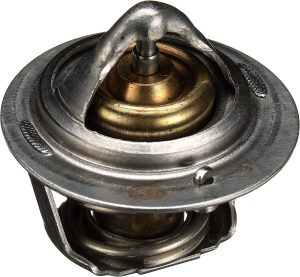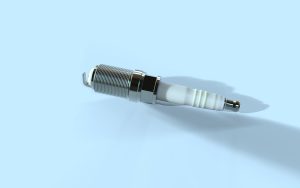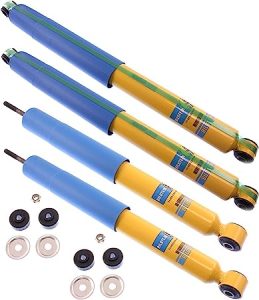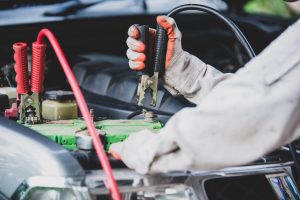Car owners frequently encounter the dangerous and inconvenient issue of engine overheating, making it a critical problem to address. It happens when your vehicle’s internal temperature surpasses its normal operating range, which can lead to severe damage if left unchecked. As a result, understanding how far can you drive an overheating car becomes essential knowledge for any driver. In this blog post, we’ll cover identifying if your car is overheating and how far can you drive an overheating car before doing further damage. Furthermore, we have compiled a list of useful advice to prevent the issue of overheating from happening again. Keep reading and discover these tips!
Table of Contents
ToggleHazards of Driving an Overheating Car
Before we explore the potential of how far you can drive an overheating car, let’s discuss the risks and dangers associated with this hazardous decision.
Engine Damage
An overheating car can cause severe engine damage, and hefty repair costs come with that. When the temperature of your vehicle starts to rise, it is probably because its cooling system has difficulty regulating heat.
If left unattended, an overheated engine can easily become damaged or cracked – ultimately leading you down a long and costly path of repairs or even needing a full replacement. In some cases, it could also indicate that your water pump or thermostat may need servicing.
Head Gasket Failure
One of the significant dangers of driving an overheating car is head gasket failure. The head gasket sits between your engine block and cylinder head, ensuring that compression and combustion occur effectively without allowing coolant and oil to mix. When your car overheats, it can cause the head gasket to fail, leading to a loss of compression or coolant and oil mixing, causing severe engine damage.
Reduced Braking Efficiency
When your car’s temperature gauge goes into the red, it can mean much more than simply ruining your vehicle. It could lead to hazardous results that reach far beyond the engine itself. Overheating can reduce brake efficacy and thus increase the risks of accidents. If the temperature in the engine compartment is too high, heat is transferred over to your brakes which leads to a decrease in stopping power as well as a spongy pedal feel due to boiling brake fluid containing air bubbles. As such, driving with an overheated car compromises both yours and others’ road safety!
Stranded on the Road
Motoring a vehicle that is overheating can leave you stranded in the middle of an undesirable location. In order to preserve its parts, your engine may automatically shut off once it reaches a critical temperature, leaving you with more than just an inconvenience but also endangering yourself if you are stuck on a bustling highway or experiencing extreme weather conditions.
Long-term Effects on Your Vehicle
Overheating can have lasting effects on your vehicle, causing a ripple effect of issues that can impact every system of your car. When an engine overheats frequently, it can develop premature wear and compromise the overall reliability of your vehicle. An overheated engine on a continuous basis may lead to increased repair costs, reduced resale value, and even complete engine failure.

What are the Overheating Car Symptoms?
Now that you understand the risks of taking a hot ride, how can you discern if your motor vehicle is in fact having difficulty? Here are some common signs that could indicate your car is running hot:
Rising temperature gauge
Your car’s temperature gauge is the first and most obvious sign of potential overheating problems. If you notice the gauge rising toward the red or hot zone, it’s time to take action. Usually located on your car’s dashboard, the temperature gauge monitors the engine’s coolant temperature. When the engine exceeds its heat capacity, or there is not enough coolant, the temperature gauge will warn you with a drastic spike in readings. It is critical to take this sign seriously and immediately address any underlying issues.
Steaming and smoke from the hood
One of the most noticeable overheating car symptoms is smoke or steam coming from under the hood. This usually indicates that the engine coolant is boiling and escaping the cooling system. Steam is released as a result of the engine’s high temperature, and it is more visible during colder weather or when the vehicle is in motion. When you see smoke or steam billowing out of your car’s hood, it is a certain signal that your engine has started to overheat. Pull over instantly and allow the automobile to cool down in order to avoid any irreparable damage.
Unusual smells
A distinct chemical smell, similar to a slightly sweet and burnt odor, is often emitted when the engine overheats. This can be caused by an overheated coolant or a coolant leak causing it to mix with the engine oil. You may also smell burning rubber or plasticky smells, which could be due to damaged belts or hoses. If you detect any strange smells while behind the wheel, it’s absolutely essential that you check your engine temperature and coolant level without delay.
Abnormal Engine Performance
Cars’ engines are designed to provide optimal performance at a specific operating temperature. Overheating engines may see noticeable drops in power and efficiency, making your vehicle feel sluggish or unresponsive. You may also hear knocking or pinging noises coming from the engine, which indicates that the engine’s combustion process is being negatively affected by the heat. If you notice any of these alarming signals while driving, promptly pull over to a secure place and permit your engine time to cool off.
Warning Light or Message
Today’s vehicles are equipped with cutting-edge technology that can detect when your engine is too hot. If you have this feature, a warning light or message will appear on your dashboard to alert you about the excessive temperature of the engine. Don’t disregard these warnings – they were created to protect and prevent expensive harm from occurring in your vehicle. As soon as feasible, stop driving and let the motor cool before investigating any further.
Also Read: How Long Does it take for a car to Cool Down

How Far Can You Drive an Overheating Car?
If you experience any of the symptoms discussed above, it is vital that you immediately exit your vehicle and turn off the engine. To avoid further destruction to your car, professionals suggest limiting travel in an overheated automobile to no more than a couple of miles. The longer you drive, the higher the risk of permanent engine failure or other issues that can cost thousands to repair. Avoid putting yourself and your vehicle at risk by stopping as soon as possible when symptoms occur.
It is important to make sure all warning signs are taken seriously– an overheated car can result in expensive repairs or even complete engine failure if left unchecked for too long. Be sure to check your coolant levels frequently, keep an eye out for any unusual smells or smoke, and take action as soon as you notice your engine temperature rising. Doing so can help you avoid a breakdown in the future and keep your car running smoothly.
Causes for Car Overheating
Studies show that the causes of car engine overheating can be attributed to many reasons. Knowing the potential root causes for car engine overheating is vital for drivers, as it can help them avoid expensive repairs and other damage to their car. Let’s investigate a few of the commonest causes for your vehicle encountering this problem:
Insufficient Coolant Levels
Low coolant levels in a vehicle’s system can be one of the leading causes behind car overheating. The cooling mechanism inside an engine manages heat by utilizing water and antifreeze to circulate from the motor to the radiator for proper air displacement. When the coolant levels are low, the engine struggles to maintain its optimal temperature and eventually overheats. Topping up your coolant is a simple maintenance task that every car owner should regularly perform. Furthermore, ensure you follow your vehicle’s manual to get the right coolant mixture and observe the temperature gauge to avoid this problem.
Radiator Issues
The radiator plays a vital role in the cooling system as it helps to dissipate the heat collected from the coolant. A clogged, damaged, or leaking radiator can impair your car’s cooling capacity, leading to overheating. Regular radiator maintenance can help prevent these issues. Make sure to check for any visible leaks, rust, or debris that might be impeding the radiator’s performance. Additionally, having the coolant flushed regularly will help to remove debris and keep the system in good condition.
Broken Water Pump
A water pump is responsible for circulating the coolant mixture throughout the engine and the radiator. Unfortunately, a water pump can fail due to bearing or seal issues, leading to car overheating. Visual inspections of the water pump can help identify leaks or broken parts, but in some cases, only a trained mechanic can diagnose and fix these water pump problems. Regular maintenance and observation of any performance changes in your vehicle can help to avoid potential water pump issues.
Damaged or Worn Belts and Hoses
The cooling system relies on various belts and hoses to function correctly. A damaged or worn belt can lead to overheating as it could struggle to drive the water pump or fan. Similarly, cracked or leaking hoses can result in coolant loss and an impaired cooling system. Make sure to routinely examine your vehicle’s hoses and belts, swapping out any that show signs of wear or damage in order to avoid the risk of overheating.
Malfunctioning Thermostat
The thermostat plays a critical role in regulating your engine’s temperature through its careful management of coolant flow. By ensuring that the optimal temperatures are maintained, it ensures maximum performance and efficiency from your vehicle. When it doesn’t work correctly, however, it can cause severe issues such as overheating due to its inability to open and restrict necessary coolant amounts. Monitoring your engine’s temperature gauge can provide clues to thermostat issues. If you suspect your thermostat is malfunctioning, it’s essential to seek help from a certified mechanic.

Also Read: How Long can You Drive Without a Heat Shield
Steps to Take When You Notice Your Car is Overheating
If you notice your car is overheating, here are a few steps to take:
Safety first
If you suspect that your car is overheating, the first thing you should do is ensure your safety and that of other drivers. When you have a chance, pull over to a safe location away from traffic. Turn on your hazard lights to let other drivers know that you’re experiencing a problem.
Turn off the A/C, turn on the heater
Although you may not enjoy it, your engine’s heat can be reduced through the combination of turning off your air conditioning unit and activating your heater. This is because your car’s heater works by circulating coolant through the engine, which can help to release some of the trapped heat. It’s not a permanent solution, but it can help to keep the temperature down temporarily.
Pop the hood (carefully!)
Once you’ve safely pulled over and turned off the engine, carefully open the hood to allow some of the trapped heat to escape. Be sure to use caution, as the hood and its components can be extremely hot. Do not attempt to touch or remove any parts at this point.
Check and replenish your coolant
If your car has cooled down enough, check the coolant levels in your radiator. If the coolant level is low, carefully add more coolant (be sure to use the correct type for your vehicle) or water as a temporary solution. Keep in mind that adding water will dilute the coolant, but it’s better than not having anything to fill the gap. Always make sure the engine has cooled down before opening the radiator cap to avoid burns from hot steam or coolant.
Inspect for leaks
If your coolant levels are low, you may want to check for leaks within the engine compartment. Look for any signs of fluids seeping out from the hoses, the radiator, or the water pump. A leak could be the cause of your overheating issue, and finding it early could save you from further damage to your engine.
Call for help
If despite taking these precautions, your engine still appears to be overheating, it is time for a helping hand. From roadside assistance to tow truck service that can take your car to an auto repair shop where the issue can be inspected and fixed correctly. Irrespective of how tempting it may be – never push your vehicle beyond its limits when in this overheated condition, as doing so could lead to serious (and expensive) damage.
Tips for Preventing Overheating in Your Car
Protecting your engine from overheating begins with prevention. To maintain optimal cool temperatures, here are some helpful tips to keep in mind:
- Make sure to keep up with regular maintenance, such as changing the oil and checking fluid levels.
- Install additional insulation in your car to help keep heat out and cool air in.
- Prolonged idling or driving in hot weather conditions should be avoided, but if you must do it – turn off the air conditioning and run the fan to guarantee enough airflow within your car.
- Check your radiator cap for proper seal and pressure—loose caps can cause the coolant to evaporate quickly when your car warms up.
- Have your cooling system flushed regularly and check for any clogs or leaks that may cause it to malfunction over time.
- Invest in a coolant recovery system that will help regulate temperatures more efficiently than a traditional radiator system alone could do, preventing your vehicle from overheating quickly during long drives or difficult terrain situations.
Final Words
When you are facing an overheating car, it is essential to remain composed and prioritize safety. Trying to force your vehicle beyond its limits can create further damage or, worse yet, a crash. Therefore, do not take unnecessary chances; be sensible at all times. Make sure to pull over in a safe spot and take the necessary steps outlined above before doing anything else. For added security, don’t be afraid to reach out for professional help or roadside assistance.
Additionally, routine maintenance and upkeep of your vehicle can significantly reduce the chances of overheating problems arising. With a few helpful safety measures taken beforehand, you’ll have an assurance that your journey will remain comfortable and trouble-free – no matter how long it is!







